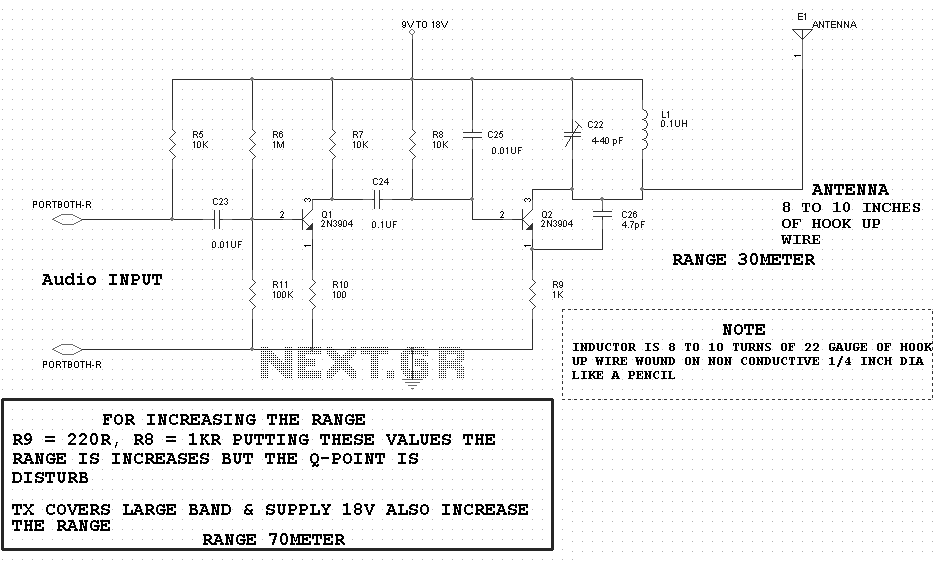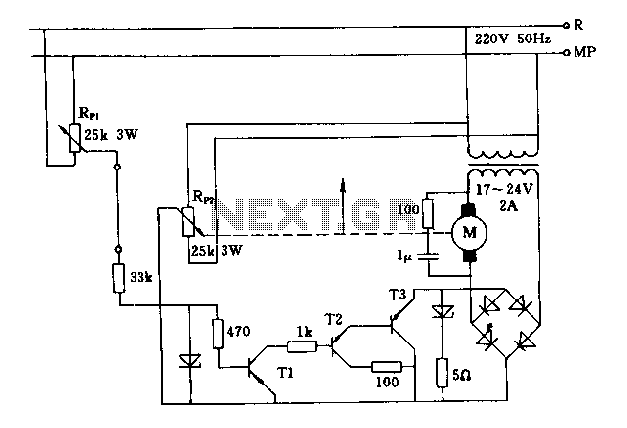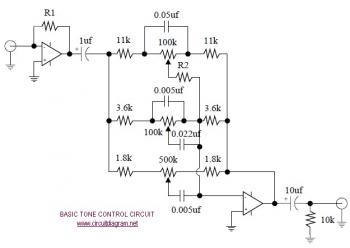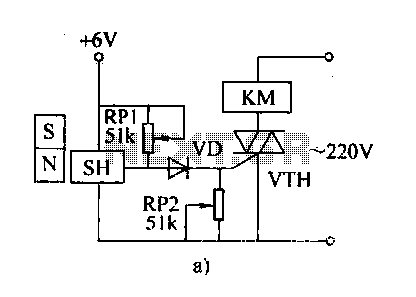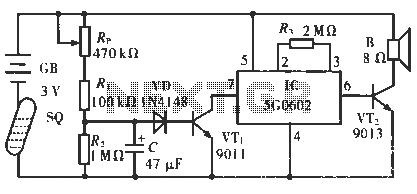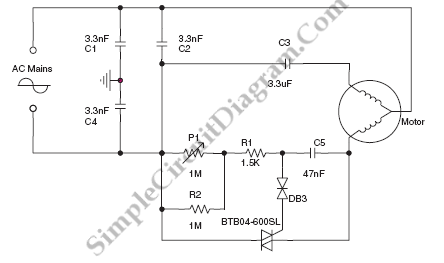
Greenhouse Heater Temperature Control Project
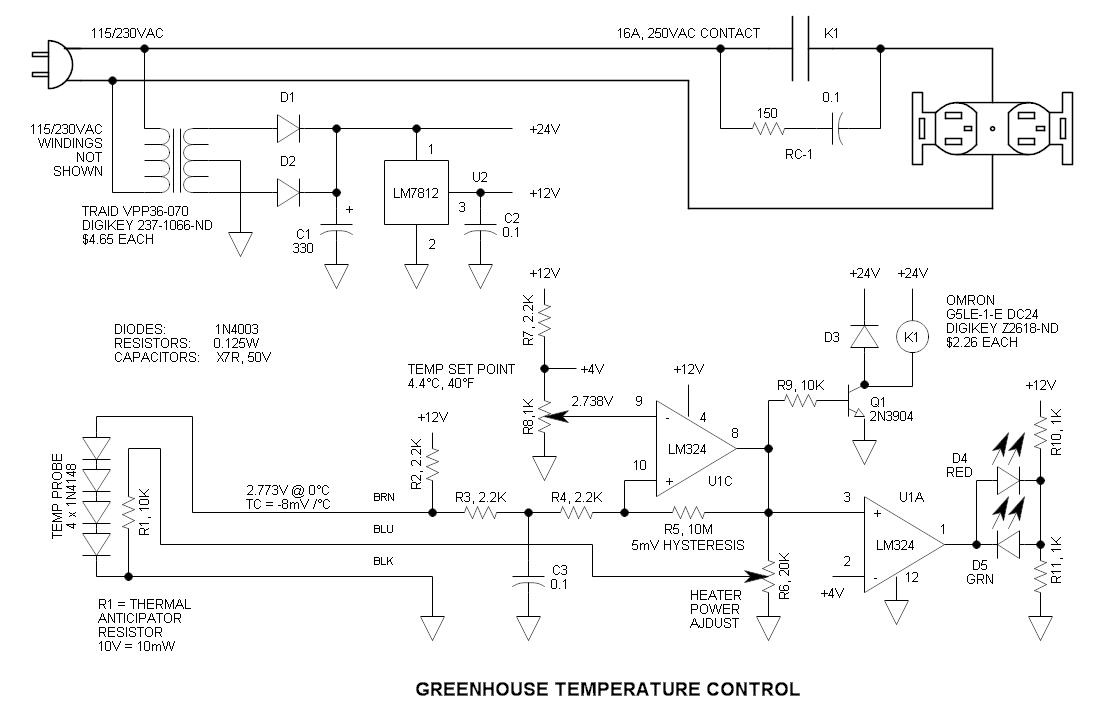
This circuit consists of four 1N4148 diodes connected in series with a thermal anticipation resistor (R1) heat-shrunk together at the end of a three-wire signal cable, which is visible in some photos. The thermal anticipation resistor is an old HVAC thermostat technique that adds negative feedback to the system by slightly heating the temperature sensing device. This approach forces short cycles and prevents temperature overshoot. To manage the power applied to the thermal anticipation resistor, a power level potentiometer (R6) was incorporated, though it was later found to work effectively at the maximum setting, making the potentiometer unnecessary. While a single diode can perform temperature measurement, using four diodes in series enhances the signal clarity. The inexpensive LM324 operational amplifier has a maximum input offset voltage of 7mV, so a higher level voltage signal improves performance. The diodes are biased at approximately 4mA via resistor R2. The U1C op-amp is configured as a voltage comparator with positive feedback through resistor R5, which prevents relay chatter. Capacitor C3 serves as an input noise filter. As the temperature decreases, the voltage drop across the probe diodes increases. When this voltage reaches the set point, the output state changes, and the positive feedback through R5 further increases the non-inverting input by 5mV to ensure that it remains latched until the temperature rises and the voltage drops below the set point. The temperature coefficient of silicon diodes is approximately -2mV/°C, and with four diodes in series, this results in a coefficient of -8mV/°C. The voltage was measured at 2.773V in ice water, and calculations were made for the voltage at 4.4°C (40°F). The voltage was then adjusted at the calibration potentiometer (R8) to achieve 2.738V, which is the set point. Proper operation was verified by placing the probe in and out of ice water to observe relay cycling. A Quencharc RC-1 is connected across the relay contacts to reduce arcing; however, a discrete resistor and capacitor are recommended due to the high cost of the Quencharc. A polypropylene capacitor is preferred, ensuring it has a sufficient AC voltage rating. The heater consists of a DIY rack of surplus power resistors rated at 500W @ 115VAC, which are robust but visually unappealing. Any resistance heater can be utilized, preferably one with a low power setting, as most heaters operate between 1500 to 1800W. The increase in energy bills has not been noticeable despite the colder weather, which may necessitate the use of a larger heater during temperatures of 10°F and below.
The circuit design utilizes four 1N4148 diodes to enhance signal clarity for temperature sensing applications. This configuration is particularly beneficial in environments where precise temperature control is critical, such as HVAC systems. The thermal anticipation resistor, R1, plays a crucial role in minimizing temperature fluctuations by introducing a slight heating effect to the sensing device, thus enhancing the stability of the system.
The operational amplifier LM324 is employed due to its cost-effectiveness and adequate performance for this application. The design ensures that the diodes are properly biased, allowing for a consistent current flow that enhances the accuracy of the temperature readings. The voltage comparator configuration of U1C, complemented by positive feedback, ensures reliable switching behavior of the relay, which is essential for controlling heating elements in response to temperature changes.
The use of a calibration potentiometer (R8) allows for precise adjustments to the set point, ensuring that the system can be fine-tuned to meet specific operational requirements. The inclusion of a noise filter capacitor (C3) is also a significant design consideration, as it helps to mitigate any potential interference that could affect the performance of the temperature sensing circuit.
Overall, this circuit exemplifies a well-thought-out approach to temperature control in HVAC systems, balancing cost, performance, and reliability. The choice of components and configuration aims to provide a robust solution that can adapt to varying environmental conditions while maintaining efficient operation.This is simply (4) 1N4148 diodes connected in series with a thermal anticipation resistor (R1) heat shrunk together at the end of a (3) wire signal cable ”it is visible on some of the photos. The use of a thermal anticipation resistor is an old HVAC thermostat technique that adds negative feedback to the system by immediately heating the temperat
ure sensing device slightly. It forces short cycles and prevents temperature overshoot. Because the amount of power to apply to the thermal anticipation resistor was unknown, I incorporated a power level pot (R6). I later determined that it works quite well at the maximum setting, so the pot is not required. Although the temperature measurement can be accomplished via a single diode, four diodes in series are used to get the signal out of the mud.
The inexpensive LM324 op amp has a maximum input offset voltage of 7mV, so the higher level voltage signal helps to improve performance. The diodes are biased at approx 4mA via R2. U1C is connected as a voltage comparator with positive feedback via R5. Positive feedback prevents relay chatter. C3 is an input noise filter capacitor. As the temperature cools, the voltage drop across the probe diodes increases. When it reaches the set point, the output changes states and the positive feedback through R5 further increases the non-inverting input by 5mV to assure that it remains latched until the temperature increases and the voltage drops below the set point.
In a previous circuit we see that the temperature coefficient of silicon diodes is approx. -2mV / °C. (4) in series boosts it to -8mV / °C. I dropped the probe in ice water and measured the voltage ”2. 773V in my case. Then I calculated what the voltage would be at 4. 4 °C (40 °F). Then I adjusted the voltage at the calibration pot R8 to get 2. 738V ”this is the set point. Proper operation was subsequently determined by placing the probe in and out of ice water to observe cycling of the relay. Quencharc RC-1 is connected across the relay contacts to reduce arcing. These are unreasonably expensive, so I recommend using a discrete resistor and capacitor. Polypropylene is the capacitor of choice ”just make sure that it has sufficient AC voltage rating; The heater is a DIY rack of surplus power resistors that work out to 500W @ 115VAC ”very rugged, large and ugly Any resistance heater may be used.
I recommend one that has a low power setting as most run 1500 to 1800W. Surprisingly, the increase in my energy bill has not been noticeable. The last two years have not been cold, but this year seems more seasonable. As a result, I may have to use a larger heater ”at least during 10 °F and below temperatures. 🔗 External reference
The circuit design utilizes four 1N4148 diodes to enhance signal clarity for temperature sensing applications. This configuration is particularly beneficial in environments where precise temperature control is critical, such as HVAC systems. The thermal anticipation resistor, R1, plays a crucial role in minimizing temperature fluctuations by introducing a slight heating effect to the sensing device, thus enhancing the stability of the system.
The operational amplifier LM324 is employed due to its cost-effectiveness and adequate performance for this application. The design ensures that the diodes are properly biased, allowing for a consistent current flow that enhances the accuracy of the temperature readings. The voltage comparator configuration of U1C, complemented by positive feedback, ensures reliable switching behavior of the relay, which is essential for controlling heating elements in response to temperature changes.
The use of a calibration potentiometer (R8) allows for precise adjustments to the set point, ensuring that the system can be fine-tuned to meet specific operational requirements. The inclusion of a noise filter capacitor (C3) is also a significant design consideration, as it helps to mitigate any potential interference that could affect the performance of the temperature sensing circuit.
Overall, this circuit exemplifies a well-thought-out approach to temperature control in HVAC systems, balancing cost, performance, and reliability. The choice of components and configuration aims to provide a robust solution that can adapt to varying environmental conditions while maintaining efficient operation.This is simply (4) 1N4148 diodes connected in series with a thermal anticipation resistor (R1) heat shrunk together at the end of a (3) wire signal cable ”it is visible on some of the photos. The use of a thermal anticipation resistor is an old HVAC thermostat technique that adds negative feedback to the system by immediately heating the temperat
ure sensing device slightly. It forces short cycles and prevents temperature overshoot. Because the amount of power to apply to the thermal anticipation resistor was unknown, I incorporated a power level pot (R6). I later determined that it works quite well at the maximum setting, so the pot is not required. Although the temperature measurement can be accomplished via a single diode, four diodes in series are used to get the signal out of the mud.
The inexpensive LM324 op amp has a maximum input offset voltage of 7mV, so the higher level voltage signal helps to improve performance. The diodes are biased at approx 4mA via R2. U1C is connected as a voltage comparator with positive feedback via R5. Positive feedback prevents relay chatter. C3 is an input noise filter capacitor. As the temperature cools, the voltage drop across the probe diodes increases. When it reaches the set point, the output changes states and the positive feedback through R5 further increases the non-inverting input by 5mV to assure that it remains latched until the temperature increases and the voltage drops below the set point.
In a previous circuit we see that the temperature coefficient of silicon diodes is approx. -2mV / °C. (4) in series boosts it to -8mV / °C. I dropped the probe in ice water and measured the voltage ”2. 773V in my case. Then I calculated what the voltage would be at 4. 4 °C (40 °F). Then I adjusted the voltage at the calibration pot R8 to get 2. 738V ”this is the set point. Proper operation was subsequently determined by placing the probe in and out of ice water to observe cycling of the relay. Quencharc RC-1 is connected across the relay contacts to reduce arcing. These are unreasonably expensive, so I recommend using a discrete resistor and capacitor. Polypropylene is the capacitor of choice ”just make sure that it has sufficient AC voltage rating; The heater is a DIY rack of surplus power resistors that work out to 500W @ 115VAC ”very rugged, large and ugly Any resistance heater may be used.
I recommend one that has a low power setting as most run 1500 to 1800W. Surprisingly, the increase in my energy bill has not been noticeable. The last two years have not been cold, but this year seems more seasonable. As a result, I may have to use a larger heater ”at least during 10 °F and below temperatures. 🔗 External reference
Warning: include(partials/cookie-banner.php): Failed to open stream: Permission denied in /var/www/html/nextgr/view-circuit.php on line 713
Warning: include(): Failed opening 'partials/cookie-banner.php' for inclusion (include_path='.:/usr/share/php') in /var/www/html/nextgr/view-circuit.php on line 713
